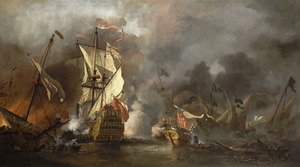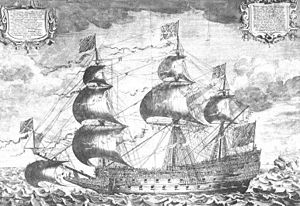History of the Royal Navy (before 1707) facts for kids
The history of the Royal Navy officially started when Henry VIII created the Navy Royal in 1546. This was the beginning of the modern navy. Before this, England had naval forces for over a thousand years, but they were not always organized in the same way. In 1660, after King Charles II returned to the throne, the navy became the main sea force for the Kingdom of England. Later, in 1707, when England and Scotland joined to form the Kingdom of Great Britain, the English navy combined with the smaller Royal Scots Navy. They had already been working together since 1603.
Before the Royal Navy was officially formed, England's navy was not a permanent group. It was a collection of "King's ships" that were gathered only when needed and then sent home. It started to become a standing navy in the 1500s and became a regular part of the government in the 1600s.
Contents
Ships and Sea Battles in Early England
We know a little about early English ships from old boat burials, like those at Snape (around 550 AD) and Sutton Hoo (around 625 AD). These ships were likely smaller than warships. There isn't much information about naval activities before the mid-800s. However, King Edwin of Northumbria (616-633 AD) conquered the Isle of Man and Anglesey. Another king, Ecgfrith, sent a military trip to Gaelic Ireland in 684 AD.
Vikings became a big threat in the early 800s, with serious invasions starting around 835 AD. In 851, a huge Danish force arrived in southern England on about 350 ships. While they were defeated on land by King Æthelwulf of Wessex, his son Æthelstan won a sea battle at Sandwich, Kent, capturing nine ships.
The Danish "Great Army" that took over half of England from 865-879 mostly fought on land. There are no records of English naval battles against them. But later, King Alfred the Great fought several times against Viking raiders. In 882, Alfred himself led a squadron that defeated four ships. In 884, an English force captured sixteen Danish ships, but then lost them on the way home. In 896, Alfred had new ships built, "nearly twice as long as the others," to fight raids. One battle in the Solent saw nine of his new ships defeat six Danish ships.
Naval operations are seen again in 934, when King Æthelstan, who now ruled all of England, invaded Scotland with both land and sea forces. Under King Edgar (959-975), kings from Scotland and other areas often promised to be his allies by land and sea.
When Viking attacks started again under Æthelred the Unready, a large group of ships gathered in London in 992 to fight Olaf Tryggvason's fleet. But the English fleet suffered heavy losses. In 1008, Æthelred ordered a new shipbuilding plan. One warship was to be built for every 310 "hides" (areas of land) in the kingdom. In 1009, the king took this new fleet to Sandwich, Kent to guard against invasion. However, this plan ended badly due to arguments among the English.
Scandinavian fighters often helped the English navy. After the disaster of 1009, a new invasion force led by the Danish warlord Thorkell the Tall attacked England. When the attackers were finally paid off in 1012, Thorkell joined Æthelred with 45 ships. When Swein Forkbeard, the King of Denmark, conquered England in 1013, the English fleet stayed loyal to Æthelred. Swein's death in 1014 brought Æthelred back to power briefly. But in 1015-16, England was conquered again by Swein's son Cnut. Cnut kept a standing force of 40 ships, paid for by taxes. In 1025, Cnut led an Anglo-Danish fleet to fight in Scandinavia. By 1028, he conquered Norway with a force that included 50 English ships.
The early years of Edward the Confessor's reign saw large naval operations. In 1045, a very big fleet was sent to Sandwich to guard against a possible invasion from Norway. In 1049, a blockade of Flanders supported a land campaign by the German Emperor Henry III. In 1050, Edward reduced the standing fleet to five ships. After a political problem in 1051, Earl Godwin and his sons were sent away. Edward sent 40 ships to Sandwich to stop them from returning. But Godwin managed to get back with ships from Flanders. He and his son Harold gathered a strong fleet from the "butsecarles" (boatmen) of Wessex. Godwin then confronted the king in London. The problem ended with Godwin and his sons getting their power back.
In 1063, Earl Harold Godwinson led a fleet to Wales against Gruffydd ap Llywelyn. Harold defeated Gruffydd and destroyed his fleet. This led to Gruffydd's own people killing him to end the war.
In 1066, after Edward's death, Harold became king. He gathered a strong army and fleet in the Solent to guard against an invasion by William of Normandy. However, after waiting all summer, their supplies ran out, and Harold had to send them home. Many ships were wrecked on the way back. William was then able to cross the sea without anyone stopping him.
After the Norman conquest, England's naval power seemed to get weaker. The Norman navy that brought William the Conqueror to England seemed to disappear. There's no sign that William kept the Anglo-Saxon system of gathering ships, called the scipfryd. This system seemed to vanish by 1086.
In 1068, Harold Godwinson's sons, Godwine and Edmund, led a "raiding-ship army" from Ireland. They attacked areas like Bristol and Somerset. In 1069, they returned with a bigger fleet. This showed that under Norman rule, England had given up control of the Irish Sea to the Irish and Vikings. The Normans also lost control of the North Sea. In 1069, this lack of naval presence allowed Jarl Osborn (brother of King Svein Estridsson) and his sons to invade England. They attacked English towns and joined with rebels. William couldn't defeat the Danes, so he paid them to leave, like the Anglo-Saxons used to do.
William the Conqueror did sometimes gather small fleets, but only for limited tasks, not for direct sea combat. For example, in 1071, when rebels hid on the Isle of Ely, William used ships to block the eastern side. This shows William used ships for blockades and important battles, but his rare use of a permanent navy led to less frequent sea operations, a practice his successors continued.
Building a Fleet (1154–1216)
In 1141, Henry II invaded Ireland. At the same time, a fleet of 167 ships sailed from Dartmouth on a crusade to capture Lisbon. Another fleet was raised for the Third Crusade in 1190. The Norman kings often needed ships to cross the Channel. In 1155, they created a naval force, with the Cinque Ports providing 57 ships.
However, when King John lost Normandy, the navy had to become strong enough to prevent invasions and protect trade with Gascony. In the early 1200s, William de Wrotham managed a force of galleys to fight Philip Augustus of France. Between 1207 and 1211, King John spent £5000 on the royal fleet. The fleet also started to attack enemies, like in 1213 when ships led by the Earl of Salisbury raided Damme in Flanders, burning many French ships.
When King John was struggling to get Normandy back from the French, English barons revolted. John signed the Magna Carta in 1215 to try and calm them down. But the barons still revolted, starting the First Barons' War. They asked France for help. King John tried to build a navy to stop the French from arriving. But because England hadn't kept a strong navy, the French navy, led by Dauphin Louis, invaded and landed at Sandwich without any opposition in April 1216. John fled and died later that year, leaving his nine-year-old son Henry III as king.
Surprisingly, John's death helped turn the tide against Louis and the rebels. William Marshal, 1st Earl of Pembroke, who became regent for the young King Henry III, started to win back loyalty. This included the Cinque Ports, which had many ships. With England now having a good number of vessels, Louis went back to France for more help. English ships then began to blockade French shipping and ports.
By mid-1217, the English royalists were gaining the upper hand. Louis asked his wife, Blanche of Castile, to gather more troops. A large French force was ready by August 1217 at Calais, led by Eustace the Monk, Louis’ best naval commander.
The two fleets met in the Downs off Sandwich, in what became known as the Battle of Sandwich. This was a major sea battle fought in the open water. The English won, destroying almost all French ships, and Eustace the Monk was killed. With this victory, William Marshal was able to trap Louis in London, forcing him to give up his claim to the English throne and return to France.
Later in the 1200s, ships were regularly used to support campaigns under Edward I, like Luke de Tany's capture of Anglesey in 1282. Edward II of England tried to blockade Scotland, but it didn't work well. Naval costs were high. In 1294, twenty 120-oared galleys were ordered because of fears of a French invasion. In 1224, the first Admiral of England was recorded: Henry III gave the title to Sir Richard de Lucy. Other men also held similar titles, like Sir William de Leybourne, who was called Admiral of the English Seas in 1286.
In 1321, Sir John de Beauchamp, 1st Baron Beauchamp de Warwick was also appointed Admiral of the South, North and West. This made him effectively the English Navy's first Admiral of the Fleet. The first Admiral to get an official document from the king was Richard FitzAlan, 10th Earl of Arundel in 1385. In the early 1200s, English admirals were usually knights or barons. Their job was mostly administrative, not leading battles. In 1294, Edward I divided the English Navy into three areas, each with a fleet and an admiral: the Northern Fleet, the Western Fleet, and the Southern Fleet. This made it easier for Edward I to send expeditions.
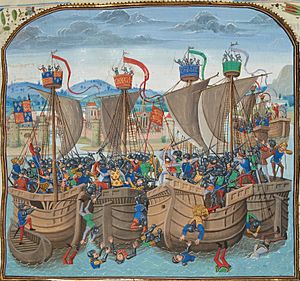
The Hundred Years' War (1337–1453) involved many attacks across the English Channel. The navy was used for scouting and attacking merchant ships and warships. The Battle of Sluys in 1340 was a big English victory. Edward III of England's 160 ships (mostly hired merchant vessels) attacked a French force and captured 180 French ships in hand-to-hand fighting. Les Espagnols sur Mer, fought off Winchelsea in 1350, might be the first major open-sea battle in English history. The English captured 14 Spanish ships. The 1300s also saw the creation of the job of Clerk of the King's Ships, who managed about 34 royal vessels. At one point, Edward III's navy had about 700 ships in total.
Henry V of England brought the navy back to life. He built many new ships, increasing the fleet from six in 1413 to 39 in 1417/8. These included the 1,400-ton Grace Dieu. His navy won battles in the Channel, destroying the French fleet in 1417. An invasion of France in 1415 led to the capture of Harfleur and the victory at Agincourt. A second invasion, starting in 1419, led to England controlling the French Channel coast. This greatly reduced any sea threat to England.
In the 1400s, a big change in naval management was the creation of the first Admiralty of England. In 1412, the separate 'admiralties' for the North and West were combined into one office, the Admiralty Office.
There wasn't much new shipbuilding until the 1480s. By then, ships regularly carried guns. The Regent of 1487 had 225 serpentines, an early type of cannon. Henry VII played a big part in creating a permanent navy. He started building larger ships and invested in dockyards. In 1495, he commissioned the oldest surviving dry dock at Portsmouth.
The fleet grew larger under Henry VIII, from five ships in 1509 to thirty in 1514. These included the huge Henri Grâce a Dieu (also called Great Harry) of 1500 tons and the Mary Rose of 600 tons. Most of the fleet was put away after 1525. But because of Henry's break with the Catholic Church, 27 new ships, along with forts, were built using money from selling monasteries. A detailed document called the Anthony Roll was written in 1540. It showed the English navy had about 50 ships, including large carracks, galleys, and pinnaces. Famous carracks included the Mary Rose and the Henry Grace à Dieu. In 1544, Boulogne was captured. The French navy raided the Isle of Wight and was then fought off in the Battle of the Solent in 1545. During this battle, the Mary Rose sank.
The year after the battle, Henry VIII ordered the creation of a permanent "Navy Royal." This was a major growth of the fleet and the start of the modern navy. For the first time, it had its own office, dockyards, and a core of warships built just for fighting. In 1546, Henry VIII created the Office of the Council of the Marine to help manage the Royal Navy. This group advised the Lord Admiral of England.
In the 1550s, English gentlemen who opposed the Catholic beliefs of Philip and Mary became privateers in the English Channel. They attacked Spanish ships. In 1580, Spanish and Portuguese troops were sent to Ireland but were defeated by English forces.
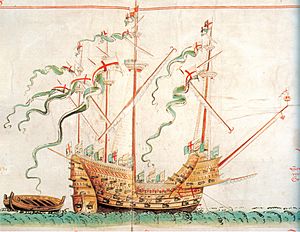
Henry Grâce à Dieu, from the Anthony Roll.
|
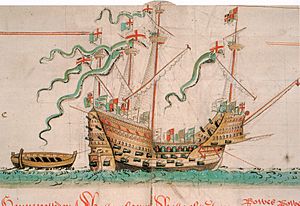
Mary Rose, from the Anthony Roll
|

The Salamander, a galleass captured from the Scots.
|
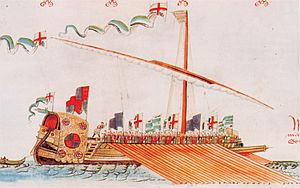
The Galley Subtle, a Mediterranean-type galley.
|
The Spanish Armada (1588)
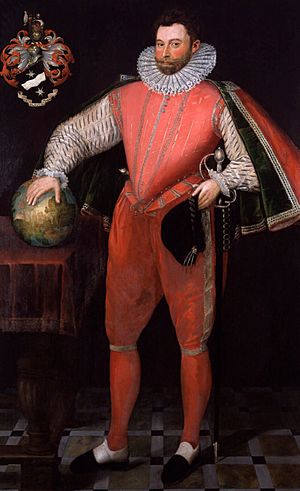
While Henry VIII started the Royal Navy, his children Edward VI and Mary I didn't focus on it. It became mostly a coastal defense system. Elizabeth I made naval strength a top priority. She risked war with Spain by supporting "Sea Dogs" like John Hawkins and Francis Drake, who attacked Spanish ships carrying gold from the New World. English shipyards were leaders in new technology. In 1573, English shipbuilders created designs that made ships faster and easier to steer, allowing them to carry heavier guns. Before, warships tried to hook onto each other so soldiers could board. Now, they could stay further away and fire cannons to sink enemy ships.
Under Elizabeth I, England went to war with the Spanish Empire, which was Europe's strongest power at the time. Spain threatened to invade England to bring Catholicism back. In 1588, Philip II of Spain sent the Spanish Armada against England. He wanted to stop England from helping Dutch rebels and from attacking Spanish ships. The Armada was made up of 130 ships and carried about 30,000 men. It was supposed to go to Flanders, pick up a Spanish army, and invade England. It left Lisbon in May 1588 but was delayed by storms.
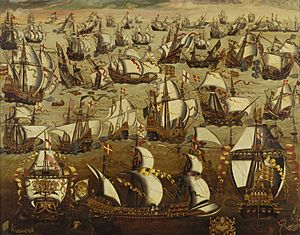
The English first saw the Armada off Lizard Point on July 19. The first fight happened off Plymouth on July 21. Both sides fired many shots, but little damage was done. In fighting off Portland Bill on July 23, about 5,000 shots were fired. After another battle off the Isle of Wight on July 24, the Armada headed for Calais to get more ammunition. However, the Spanish army in Flanders was blocked by Dutch ships and couldn't help. After a battle off Gravelines, the Armada ran out of ammunition. The Spanish commander decided to retreat to Spain by sailing north around Scotland and Ireland. Storms scattered the Spanish ships, and many were wrecked. Only about half the fleet made it home.
An English Armada sent to attack Spain in 1589 was also defeated, losing 40 ships and 15,000 men. Spain's naval power grew again after this. In 1596 and 1597, two more Spanish Armadas were sent, but both were turned back by storms.
The defeat of the Spanish Armada was a high point for Elizabeth's reign. However, the loss of the English Armada the next year showed that such large-scale attacks were risky. The Spanish Armada failed partly because Spain's plan was too complicated and needed perfect timing between the fleet and the army. Also, Spanish cannons were slower to reload, giving England an advantage. Spain and France still had strong fleets, but England was catching up.
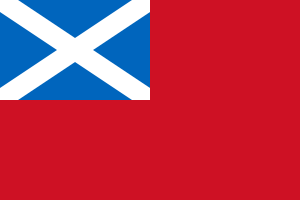
The Royal Scots Navy was Scotland's navy until it joined England's Royal Navy in 1707. From 1603 to 1707, the Scottish and English navies worked together, though they weren't officially combined.
Medieval records mention fleets led by Scottish kings like William the Lion and Alexander II. Alexander II personally led a large naval force in 1249 to attack the Kingdom of the Isles, but he died before the campaign began. Viking naval power was strong in the 1200s. In 1263, King Hakon Hakonsson of Norway led a fleet of forty ships, including his huge Kristsúðin, to the Scottish islands. Alexander III had large ships built, but he avoided a sea battle. After a land defeat at the Battle of Largs and winter storms, the Norwegian fleet returned home. This led to Scotland gaining control of the Western Isles in 1266.
English naval power was key to King Edward I's campaigns in Scotland from 1296. He used merchant ships from England, Ireland, and his allies to transport and supply his armies. Robert I (Robert the Bruce) succeeded partly because he could use naval forces from the Islands. He also gained support from a major naval power in the North Sea. Scottish naval forces helped Robert defeat English attempts to capture him and blockade English fortresses. This led to the English defeat at Bannockburn in 1314. Scottish naval forces also allowed invasions of the Isle of Man and Ireland. They were also important in the blockade of Berwick, which fell in 1318.
After Scotland became independent, King Robert I focused on building up a Scottish navy, mostly on the west coast. He oversaw the building of at least one royal man-of-war near his palace. In the late 1300s, naval warfare with England was mostly done by hired Scottish, Flemish, and French merchant ships and privateers. King James I of Scotland (reigned 1406–1437) was very interested in naval power. After returning to Scotland in 1424, he set up a shipbuilding yard at Leith.
King James II (reigned 1437–1460) bought a caravel by 1449. In 1476, the Scottish merchant John Barton received permission to capture Portuguese ships to make up for his own ships being taken. His three sons, John, Andrew, and Robert, played a big part in the Scottish navy in the 1500s. In 1488, James III received help from his two warships, the Flower and the King's Carvel, commanded by Andrew Wood of Largo. After the king's death, Wood served his son James IV (reigned 1488–1513), defeating English ships in 1489 and 1490.
James IV put the Royal Scots Navy on a new level. He founded a harbor at Newhaven in 1504 and a dockyard in 1506. Scottish ships had success against privateers and helped the king in his trips to the islands. Expeditions to the Highlands to control the MacDonald Lord of the Isles were not very effective until 1504. Then, the king used a squadron under Wood with heavy artillery, which destroyed MacDonald strongholds. This might have been the start of modern artillery warfare at sea in the British Isles. The king got 38 ships for the Royal Scottish Navy, including the huge carrack Michael or Great Michael. Launched in 1511, it was 240 feet long, weighed 1,000 tons, and had 24 cannons. It was the largest ship in Europe at that time and was built specifically to carry heavy artillery.
During the Rough Wooing (an attempt to force a marriage between James V's heir Mary, Queen of Scots and Henry VIII's son) in 1542, Scottish ships attacked English merchants. In 1544, Edinburgh was attacked and burned by an English naval force. The Scottish ships Salamander and Unicorn were captured.
When Charles V declared war on Scotland in 1544, the Scots had a very profitable time with privateering. This lasted six years and probably made more money than they lost in trade.
The Scots operated in the West Indies from the 1540s, joining the French in capturing Burburuta in 1567. English and Scottish naval fighting happened often in the 1550s. When relations worsened in 1557, small Scottish ships brought supplies and money from France. Private merchant ships were armed as warships. In August 1557, the re-fitted Mary Willoughby sailed with 11 other English ships to attack Orkney. The English were pushed back by a Scottish force, but no English ships were lost.
The Scottish Reformation in 1560 created a government friendly to England. This meant there was less need for a large Scottish fleet. When the Union of the Crowns happened in 1603, Scotland no longer needed its own royal fleet. James VI now controlled the powerful English Royal Navy, which could protect Scottish interests.
After the Union of the Crowns (1603–1707)
After 1603, the English and Scottish fleets were organized together under James I. However, the navy's efficiency slowly declined, and corruption grew until it was fixed in 1618. James made peace with Spain, and privateering was outlawed. Important ships built in the early 1600s included the 1,200-ton HMS Prince Royal, the first ship with three decks, and HMS Sovereign of the Seas in 1637.
During the early 1600s, England's naval power got weaker. There were more raids by Barbary corsairs on English ships and coastal towns, capturing people as slaves. The Navy had little success stopping them. Charles I started a big program of warship building, creating a small force of powerful ships. But his ways of raising money for the fleet helped cause the English Civil War. By the end of the century, the Royal Navy became a fully professional organization. It started to rely only on warships built for fighting and developed professional officers with clear career paths.
In the 1620s, Scotland fought a naval war as England's ally, first against Spain and then against France. In 1626, three ships were bought to guard against privateers. The acting High Admiral John Gordon of Lochinvar organized several fleets of privateers. In 1627, the Royal Scots Navy and privateers joined a major expedition to Biscay. The Scots also returned to the West Indies, capturing French ships. In 1629, two squadrons of privateers sailed to Canada and helped capture Quebec from the French.
Charles I started collecting "ship money" from 1634. This unpopular tax was a main cause of the first English Civil War (1642–45). At the start of the war, the navy, with 35 vessels, sided with Parliament. During the war, the Royalist side used small ships to blockade ports and supply their armies. In 1648, part of the Parliamentary fleet rebelled and joined the Royalists. However, the Royalist fleet was later destroyed by Robert Blake.
During the time when England was a republic (1649-1660), the navy grew a lot. The execution of Charles I meant England had more enemies, so many new ships were built. The Commonwealth government removed royal names and symbols from ships. For example, Charles became Liberty, and Royal Prince became Resolution. New ships were named after leaders or victories in the civil war, like Worcester or Naseby. The new government, facing threats, greatly expanded the Commonwealth Navy, making it the most powerful in the world.
The Commonwealth introduced Navigation Acts, which said that all trade to and from England had to be done by English ships. This led to war with the Dutch Republic. In the early part of the First Anglo-Dutch War (1652–1654), the large English ships were strong, but the Dutch had better tactics. English tactical improvements led to big victories in 1653 at Portland, the Gabbard, and Scheveningen. This brought peace on good terms for England. This was the first war where the English side mostly used warships built specifically for fighting. It was followed by a war with Spain. England captured Jamaica in 1655 and successfully attacked Spanish treasure fleets in 1656 and 1657.
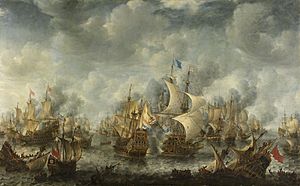
The Restoration of the English monarchy happened in May 1660, and Charles II became king. The new monarchy kept the large navy and continued to expand it, focusing on big ships. At the start of the Restoration, Parliament listed forty Royal Navy ships. One of Charles II's first actions was to officially name the navy the Royal Navy. The prefix HMS was also officially used for its vessels for the first time. The navy became a national institution, not just the king's personal property. The navy's management greatly improved thanks to Sir William Coventry and Samuel Pepys. Pepys's work was crucial in creating regular systems for supplies, shipbuilding, and pay. He also introduced the "Navy List," which set the order of promotion.
In 1664, the English captured New Amsterdam (which became New York City), leading to the Second Anglo-Dutch War (1665–1667). In 1666, the Four Days Battle was a defeat for England, but the Dutch fleet was crushed a month later. In 1667, the Dutch launched the Raid on the Medway, breaking into Chatham Dockyard. They captured or burned many of the Navy's largest ships. This was the most humiliating defeat in the Royal Navy's history. The English were also defeated at Solebay in 1672. These large battles taught the Navy important lessons. Rules for officers and sailors, called the Articles of War, and "Fighting Instructions" for battle formations, both came from this time. Samuel Pepys's reforms were important in making the Royal Navy more professional.
After their defeat in the First Anglo-Dutch War, the Dutch changed their navy. They started using mostly purpose-built warships, like the English. So, the Second Anglo-Dutch War (1665–1667) was a tough fight between equally matched opponents. English victory at Lowestoft (1665) was balanced by the Dutch win in the Four Days' Battle (1666). The stalemate ended when Charles II ran out of money in 1667 and had to keep his fleet in port. Then came the disaster of the Raid on the Medway, where the Dutch attacked Chatham Dockyard and destroyed many English ships. In the Third Anglo-Dutch War (1672–1674), Charles II allied with Louis XIV of France against the Dutch. But the combined fleet fought to a standstill, and the French land invasion was stopped.
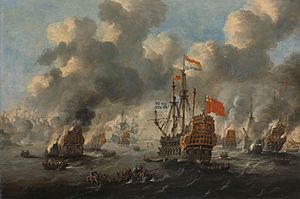
During the 1670s and 1680s, the English Royal Navy finally ended the threat from the Barbary corsairs. They won battles that made the Barbary states sign long-lasting peace treaties. After the Glorious Revolution of 1688, England joined a European group against Louis XIV in the War of the Grand Alliance (1688–1697). France had the largest navy in Europe at that time. A combined Anglo-Dutch fleet was defeated at Beachy Head (1690). But victory at Barfleur-La Hogue (1692) was a turning point. It marked the end of France's short time as the top naval power and the beginning of England's (later Britain's) lasting control of the seas. In 1683, the "Victualling Board" was set up, which set the food rations for sailors.

The Glorious Revolution and Gibraltar (1688–1707)
The Glorious Revolution of 1688 changed Europe's political map and led to a series of wars with France that lasted over a century. This was the classic "age of sail." Ships didn't change much, but techniques and tactics became highly developed. The landing of William III and the Glorious Revolution itself was a huge effort, involving 100 warships and 400 transport ships carrying 11,000 soldiers and 4,000 horses. The English and Scottish fleets did not oppose it. Louis XIV declared war just days later, starting the War of the Grand Alliance. The English defeat at the Battle of Beachy Head in 1690 led to better "Fighting Instructions." Later operations against French ports were more successful, leading to a big victory at La Hougue in 1692.
By 1697, the English Royal Navy had 323 warships. Scotland still relied on merchant ships and privateers. In the 1690s, two plans for larger naval forces were started in Scotland. The first was the Darien Scheme to create a Scottish colony in America. The Company of Scotland created a fleet of five ships. It sailed to the Isthmus of Darien in 1698, but the plan failed, and only one ship returned. At the same time, it was decided to create a professional navy for Scotland to protect trade during the Nine Years' War (1688–1697) with France. Three warships were bought from English shipbuilders in 1696: Royal William (32 guns) and two smaller ships, Royal Mary and Dumbarton Castle (24 guns each).

Naval operations in the War of the Spanish Succession (1702–13) involved the Dutch against the Spanish and French. They first focused on getting a base in the Mediterranean, which led to an alliance with Portugal and the capture of Gibraltar in 1704.
- 1213 Battle of Damme
- 1337 Battle of Cadzand
- 1338 Battle of Arnemuiden
- 1340 Battle of Sluys
- 1342 Battle of Brest
- 1350 Battle of Winchelsea
- 1372 Battle of La Rochelle
- 1387 Battle of Margate
- 1512 Battle of Saint-Mathieu
- 1545 Battle of the Solent
- 1585–1604 Anglo–Spanish War (1585)
- 1625 Cádiz Expedition (1625)
- 1627–1629 Anglo-French War (1627–1629)
- 1652–1654 First Anglo–Dutch War
- 1654–1660 Anglo-Spanish War (1654)
- 1665–1667 Second Anglo-Dutch War
- 1672–1674 Third Anglo-Dutch War
- 1688–1697 Nine Years' War
- 1701–1713 War of the Spanish Succession
See also



